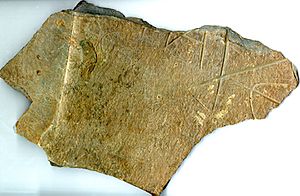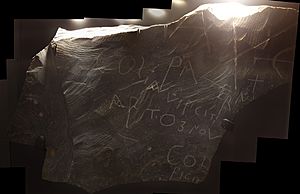Artognou stone facts for kids
The Artognou stone is an old stone found in Cornwall, United Kingdom. Some people mistakenly call it the "Arthur stone." It was discovered in 1998 at Tintagel Castle in Cornwall. This castle was once an important settlement during a time called sub-Roman Britain, which was after the Romans left Britain.
The stone was found in layers of earth that date back to the 500s. It seems the stone was first used for practicing writing for a building or public structure. Later, it broke in half and was used again as part of a drain when the first building was destroyed.
When the stone was found, it became famous because some people thought the name "Artognou" might be linked to the legendary King Arthur. However, experts like John Koch have said there isn't enough proof for this connection. Today, you can see the Artognou stone at the Royal Cornwall Museum.
Contents
How Old Is the Artognou Stone?
Archaeologists used two main ways to figure out how old the Artognou stone is:
Finding the Stone's Age
- Where it was found: The stone was discovered in layers of soil that also contained pottery from the 400s and 500s. This pottery is known to be from that time period.
- The way it's written: The style of the letters carved on the stone is similar to other writings found on British stones from Scotland to Cornwall. These styles were common after the year 500, especially in north Cornwall, which was part of an old kingdom called Dumnonia.
What Is Carved on the Stone?
At the top right of the stone, there's a deep carving. It looks like the letter A and another incomplete letter on either side of a large diagonal cross. This symbol might be a common Christian sign called a Christogram. A Christogram often shows the Greek alphabet letters Alpha (A) and Omega (Ω) next to a large Greek letter Chi (X), which stands for "Christos" (Christ).
Below this, there's a smaller, lighter carving in Latin. It reads: PATERN[--] COLI AVI FICIT ARTOGNOU. This same message seems to be repeated lower down. Only the letters COL[.] and FICIT can be seen on the broken piece. Because the carving is light, and it overlaps the Christogram, experts think it might have been like "graffiti" or practice writing, not a formal message.
What Does the Inscription Say?
The Celtic Inscribed Stones Project has translated the Latin writing. It means: "Artognou, descendant of Paternus Colus, made (this). Colus made (this)."
The name Artognou means "Bear Knowing." It comes from old Brittonic words: arto meaning "bear" and gnāwo- meaning "to know." This name is similar to the Old Breton name Arthnou and the Welsh name Arthneu.
Other Discoveries at Tintagel
When Tintagel Castle was dug up in the 1930s by C. A. Ralegh Radford, archaeologists found many other interesting things from the 500s. These included expensive pottery, glass items, and coins. Some of these came from as far away as Visigothic Spain and the Byzantine Empire. This shows that Tintagel was an important place that traded with distant lands.
See Also



